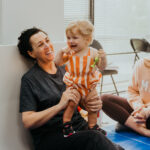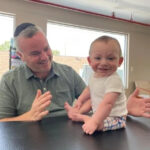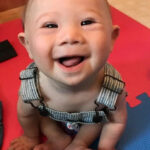No products in the cart.
October 31, 2021
DMI Therapy

By Jo-Anne Weltman B.Sc. PT MRSc (Physiotherapist) - Owner of SMILE Therapy For Kids
There are critical periods or “windows of opportunity” when developmentally appropriate movement and sensory experiences may be most beneficial in the developmental process to optimize general brain and motor development. If a child misses this opportunity, his or her brain may not develop its circuitry to its full potential.
The windows of opportunity begin before birth and then narrow as a child grows older. This does not mean that we stop learning, as considerable restructuring and learning can still takes place over our lifetime, but the amount of learning and the strong foundation for certain areas of learning can be achieved during these times. For example it’s easier for young children to learn new languages, it then also becomes easier for them to learn other languages later in life.
The fetus starts moving in utero at 6 weeks gestational age. These movements are created by Central Pattern Generators (CPG) within the central nervous system. The movements stimulate and ensure that other areas of the fetus begin to develop and grow correctly. If any of these movements are are somehow prevented or halted, deformities of the skeletal system and problems with organ formation can occur. e.g. diaphragmatic hernia. The movements also send sensory information to our brains to start programming and connecting pathways. These movements occur until 20 weeks post natal and gradually become voluntary due to motor learning and the connections that have been formed. These connections are dependent upon stimulation from the environment and experience in the environment. It is this motor and sensory stimulation that completes the architecture of the brain.
The window of opportunity for gross-motor skills, is from the prenatal period to around age five. During this period sensory and motor experience is important for the brain circuits dedicated to motor control to develop. As the child moves about in their environment they gain experience and develop and map essential skills in spatial relationships, timing, motor planning and coordination, which are the building blocks for math and language skills. Physical activity is a strong determinant and the foundation of the early development of the entire brain, not just motor control. Fine muscle development requires a strong basis to develop from. Gross-motor development and core muscle control are needed for learning skills that require a high degree of manual dexterity.
The motor synapses within the cerebellum, which controls posture, balance, refined and coordinated movements develop during the first two years. The cerebellum, visual and vestibular systems need to co-ordinate for reading and writing skills to develop in later years.
The use of movement experiences stimulate problem-solving abilities, critical thinking, and reinforce a variety of academic concepts, creating a multi-dimensional mental model of the experience.
Unfortunately, we have found that the average child is now lagging 4-6 weeks behind in developmental milestones. Many children are bypassing important milestones and experiences and are demonstrating difficulties in attention and academics at school.
With so much conflicting and information available to us and the availability of new trendy gadgets and toys that are supported strong advertising and promotion, we are often guided into making decisions for our children that may not always be the best choices.
Studies have shown that when a baby is strapped into a carseat they move their legs significantly less than when lying on the floor. Equipment such as exersaucers are known to prevent babies from developing rotational muscles. Exersaucers and Jolly jumpers can cause one group of muscles to overdevelop resulting in toe walking. Car seats that can be moved from the car to a stroller, keep a baby restrained for prolonged periods of time. Baby swings, bumbo chairs, bouncers and even excessive swaddling, also immobilize the baby for prolonged periods of time. Babies need to constantly move to ensure new synapses to connect in the brain, for the brain to map out its environment and develop a body schema and for primitive reflexes to integrate.
Many school aged children, are assessed to have retained primitive reflexes that should have integrated with movement when they were babies. These reflexes contribute to problems with focus and attention, bedwetting and fine motor skills, to name a few.
Children with developmental delays are greatly limited in movement experiences.
So how can we as parents ensure that we are correctly stimulating and exposing our children to enriched environment for optimal growth and development? What can we do at each age and stage to ensure that they are getting the right amount of movement and stimulation?
DMI Therapy can help provide enriched movement experiences for children with delays. As parents you too can help expose your children to movement. We are here to help teach and support you on this journey.
References
Diamond, A. (2000). Close interrelation of motor development and cognitive development and of the cerebellum and prefrontal cortex. Child development, 71(1), 44-56.
Doidge, N. (2007). The brain that changes itself: Stories of personal triumph from the frontiers of brain science. Penguin.
Fischer, K.W., & Rose, S.P. (1998). Growth cycles of brain and mind. Educational Leadership, 56 (3), 56-60.
Gabbard, C and Rodrigues, L. Optimizing Early Brain and Motor Development Through Movement. Early Childhood News. Retrieved from http://www.earlychildhoodnews.com/earlychildhood/article_view.aspx?ArticleID=360
Hadders-Algra, M., & Prechtl, H. F. R. (1992). Developmental course of general movements in early infancy. I. Descriptive analysis of change in form. Early Human Development, 28(3), 201-213.
Hannaford, C. (1995). Smart moves: Why learning is not all in your head. Great Ocean Publishers, Inc.
Kolb, B., & Gibb, R. (2011). Brain plasticity and behaviour in the developing brain. Journal of the Canadian Academy of Child and Adolescent Psychiatry, 20(4), 265.
Liddle, T. L., & Yorke, L. (2004). Why Motor Skills Matter: Improve Your Child’s Physical Development to Enhance Learning and Self-esteem. Contemporary Books.




